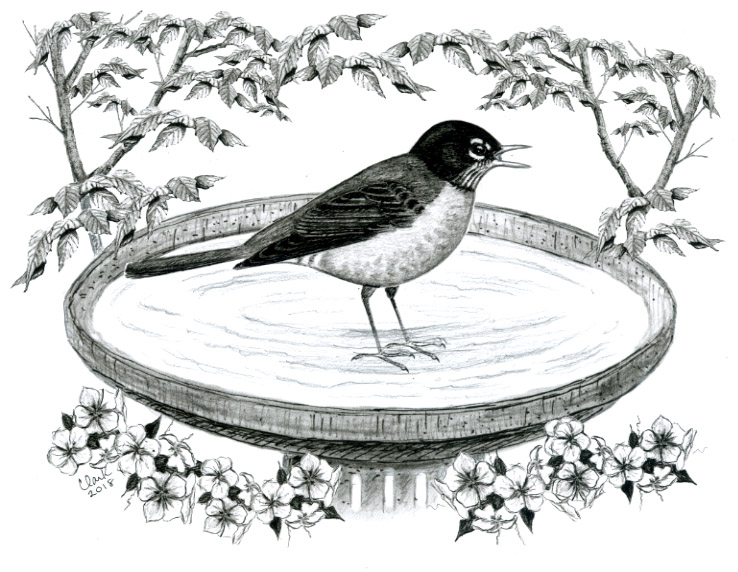
Dear Bird Folks,
Much has been written on how birds have adapted to winter’s frigid weather; but what about summer? Has anyone studied how birds are able to cope with these recent heatwaves?
– Jack, Boston, MA
They have, Jack,
I don’t think there is a single facet of bird behavior that someone somewhere hasn’t studied. Did you know that a pigeon has thirty-seven taste buds? I don’t know why, but somebody felt there was a need to count them. A hummingbird’s brain is roughly four percent of its body weight, according to someone with a much better scale than I have. There even has been a study to determine if birds can pass gas. Yes, you read that right. Time was spent trying to figure out if birds are able to fart. I’m not sure who initiated this study, but my guess it was an eight-year-old boy.
During the cold days of winter, many humans keep themselves warm by bundling up in toasty down jackets. When summer rolls around, they simply replace the jackets with sundresses or tank tops. Birds, of course, started using the down jacket method long before we discovered it. Unfortunately, their down jackets need to stay in place year-round. Without feathers, they have no protection from the elements or ability to fly. Besides, most birds wouldn’t look good in a sundress…except for maybe cardinals.
The first thing birds do when they become too warm is pant, just like dogs; only with birds it’s a lot less disgusting. When birds pant, their tongue doesn’t hang out a foot-and-half, they don’t drool all over the furniture, and bird breath won’t take the paint off a car. In addition to panting, some birds will also flutter their gular area. What’s the gular area? (This should keep the eight-year-old boys guessing for a while.) The gular is part of the throat and rapidly vibrating it helps expel heat. Anyone who has been to a local raptor demonstration has probably seen one of the owls doing a little gular fluttering. The slightly stressed bird is just trying to remain cool while crowds of excited people take selfies with it.
Humans typically don’t pant or do any gular fluttering. Instead, we sweat (and some folks do it more than others). I know sweating is a good thing, since it’s supposed to help cool us off, but lately I’m getting a little tired of it. Yesterday, I had to change my shirt twice (although a dripping ice cream cone was the real problem). Birds, on the other hand, don’t sweat at all. They have very little bare skin, so sweating wouldn’t do them much good. But birds do have a beak, which is a source of heat loss. (This is why birds bury their heads in their feathers when they sleep.) When they get too warm, some birds pump extra blood into their beaks, which helps to dissipate unwanted body heat. Birds will also spread their wings and fluff out their feathers in order to allow cooler air to reach their skin. Here’s a good question: Birds have wings, right? So, why don’t they just fan themselves when they get too hot? Someone should do a study on that.
I think most birds deal with hot weather exactly the same way we do; they try to avoid it. Consequently, they are more active early in the morning and hide out during the heat of the day. By noontime, the feeders at my house look like a ghost town, or the parking lot in front of Sears. When it comes to finding cool air, birds of prey take things to a new level, a much higher level. Instead of baking on the ground with the rest of us, large raptors will take off and spend time circling and soaring where the air is thinner and more refreshing. But my all-time favorite method of beating the heat belongs to vultures. When they become overheated, they will actually pee on their own legs. It is thought that the subsequent evaporation helps cool the birds down. I’m not sure if scientists are in total agreement on this last one, but this is one study I’d rather not participate in.
What can you do to help birds in hot weather? It’s simple; keep your birdbath water clean and fresh. Just like us, birds like to go for a quick dip when they need to cool down. My birdbaths are exceptionally busy right now. As we speak, there is a robin splashing around in the bath in my backyard and there is an oriole trying to push it out. (Good luck, Mr. Oriole. That robin isn’t going anywhere.) Birds especially like moving water. Even the fountains in city parks get lots of avian activity, and more than one customer has reported seeing birds running (flying) through their lawn sprinkler. (Don’t you miss doing that?)
Speaking of hot birds, here’s something interesting: Most baby birds are born pink and naked, which should make them super-sensitive to the sun. But like sweating, birds don’t get sunburned, not even the babies. Their skin has natural built-in sunscreen. Man, I wish I had that kind of skin. My relatives are from Ireland, so I have to wear SPF 100 just to use a flashlight.
Whether it’s cold or hot, Jack, extremes are tough on birds. Fortunately, evolution has provided them with the skills needed to survive. We know that in order to cope with heatwaves birds pant, flutter their gulars and run through sprinklers. We just don’t know if they are able to fart. Once again, that’s a study I’d rather not be involved in. They can give my spot to the nearest eight-year-old boy. He’ll love it.